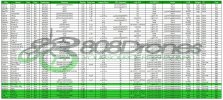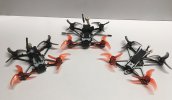Advice from hardcore fpv aerobatic pilot follows...
STOP
Don't buy any goggles. Don't buy any quad copter.
In fact, don't even proceed past this sentence if you are not a computer technical whiz (can build a PC, for example) and have flashed firmware before, are fine watching tons of Youtube how videos, know how to solder, have a gaming PC (quad core or higher) rig with decent 3D video card, and have previous experience flying in other games. Also, deep pockets. Your going to be building flying robots, and crashing them. A lot. It's really a very foolish, rich man's hobby, but I'll outline how you can mitigate somewhat lighting a whole lot of $100 bills on fire.
If you meet those things, particularly the computer skillz, then proceed. You'll eventually be doing a lot of connecting your equipment back and forth to the PC.
But that's not where you're going to start.
Step 1. Buy a transmitter as your first piece of kit. You'll be using it as a controller.
If your heart has chosen the Tango, then buy it first. I hate the Tango myself, not enough switches, but this is you, not me. Always buy what makes you happy. You're going to be living with it. Even if it's more expensive, buy what makes you happy.
Step 2. Buy a simulator. There really are only 3... Liftoff, Velocidrone, and DRL. If you are broke as hell, buy Velocidrone. If you want to race, buy DRL. If you want to Freestyle, buy Liftoff. Myself, there is nothing but free style, so Liftoff on Fantastic settings makes the other two simulators look like so much rotten ****. I started with Velocidrone and learned to turn in it, but that was about it. I have DRL, and find racing good at improving your technical skills shooting gates and gaps, but otherwise, inane and tedious. In real life, IMHO, at least me, I'm going to be flying alone in the countryside. My gaps and gates are going to be trees. If you have no idea which three you want, I plug Liftoff. It's the caddilac of sims, and only $20. You can get the other two if you want as well, no reason not to own all three. They are cheap. Very cheap.
Step 3. Fly in the Sim. Every day. Hours a day. Like it was your favorite video game. Because it's about to become it. Put 50 hours into, put 100, put 200, put 500, put 1000, put 3000... I'm not kidding. I'm at 1229 hours in Liftoff and can do half of everything I could ever dream. I can see myself putting in another 2000 to be god mode and do every Hail Mary pass I can dream up.
But learn to turn, learn to fly acro, learn to to do stunts, shoot gaps, orbit tree trunks, flat orbit water towers, loop, and a dozen other stunts I can't even name. Become an expert pilot before you ever buy a thing more. Seriously. Would you go out and buy an airplane and then learn to fly it by cranking it up and taking it off. Sadly,t hat's what most people are doing in this hobby, and they are trying to learn the ahrd way.. by busting up equipment after equipment after equipment.
Step 4. If after 1000 hours, you are not bored to tears, then go shopping for your other junk. In real life flying is no where near as fun or convenient as the sim. All the time you're Sim Flying and learning, also be comparison shopping, compiling lists, getting recommendations, price shopping. Not just a controller, goggles, and a quad... you'll need a big forth category... batteries and chargers.
Up until Step 3, you can fly for thousand hours on less than $150... if you get a Realflight Controller instead ... $50 bucks even ($30 for controller and $20 for Liftoff). That's some mighty cheap price for infinite flying and infinite flight school. Use it. Do it.
Step 4 and higher, it goes up to $1000, $1500, $2000, $2500, $3000... and keeps going.
If you want to progress rapidly, you'll spend 99% in your Sim. It would make sense, to put yoru focus and money there first.
That's my advice, It's the difference between jumping into a street fight holding a butter knife... or jumping into a street fight after you've played 1000 hours of Mortal Kombat, and taken another 1000 hours of martial arts classes in real life.
Controller. Sim. 1000 hours.
I'm not joking.
Investment cost: $50-$200. If you find it's not for you, sell the controller, get most of your money back.
Learn to drive, and better, learn to drive defensively and drift and practice, before you ever set foot near a new car lot and drop $50,000 on a new car you have no clue how to fly yet.
It doesn't start at buying the car. It starts, at learning to fly.
You can do it the other way, buying the car, and smashing them up one after another, and many go that route, and learning to drive that way. Eventually you get pretty decent at driving, maybe even really good, after a whole lot of cars and a whole lot of gasoline and rubber.
My way, though, you'll do it way faster, progress at lightning speed, way cheaper, and have way more fun.
For example, Bardwell for a month as a personal challenge, flew 3 packs a day. One pack = 5 minutes of flight. So he flew about 15 mintues per day for a month. That's 30x15= 450 minutes in a month, or 450/60 = 7.5 hours.
I fly 2-3 hours every day just for fun. Pleasure cruising, pushing my skills, trying new things. That's 2.5x30= 75 hours... or ten times as much. Wasn't any personal challenge, it was just me everymonth gaming for 2 hours a day, like a lot of gamers do anyway to unwind.
Choppergirl
CHOPPERGIRL's AIRWAR
My Sound pack:
Choppergirl's Edgy Sound Pack for Open-TX English
Interesting side note:
I spent like a month (of a year of Sim flying) in a Sim just overall fine tuning up and down by a point here and there tin a quest to finding my ideal rates and stick lengths. You could never do that in real life. In fact, most people don't... they use the default 1.00 / 0.70 Betaflight stock rates, which have to be the worst ever. I don't know how anybody pulls off flying with them, but they do, and it's a curse.
You can tell they are using them, because their FPV aerobatic footage looks like a marble in a washing machine, hard bouncing and then drifting whenever they have to make a turn. They call it "juicy" flying, but it's really a cursed way of compensating for lack of resolution at the center of the stick of trying to fly horrible default rates. I call it ping pong table tennis turning. I suspect the Betaflight team must of asked someone they thought was a pro in the very beginning, well, what are the ideal rates we should set this around,w hat do you use... and he told them the crackhead meth number he was using to do flippy flops.
If you watch my flying, it's smooth as butter because I worked a long to time to increase the resolution around the center of my sticks to the absolute highest I could get away with and to find my ideal rates to match how my brain expects the sticks to work. I have super high resolution around the center of the stick. If I do a hard slam reverse in direction, it's because I want to, not because it's the only way I can change direction and make it look cinematic. Fling for me is not this after that, it's let my fingers do whatever they want and my fingers follow my brain and go where I want and do what I want without even thinking about it.
Don't worry about PIDs in the beginning, the stock ones will work. Strive to experiment and find your ideal rates after you reach intermediate level and can mostly wherever you want all over a map. When you try a better rate, you will find you crash less, and can suddenly do something that was very impossible or twitchy or hard to do before.
The first thing you're going to have to do is learn to turn. Once you learn to turn, the whole world opens up to you, and you can kind of mostly go where you want to go to explore the map.
Getting a controller, getting a sim, and learning to turn in the sim will be your very first goal or milestone. No quads, no goggles, no battery purchases, no buying bottom end BNF angle only toy quads to get a taste of the hobby (waste of money, you can see it in reviewers videos, they have a wall of those as decorations behind them as useless junk they'd never fly any mroe).
 . Whereas some other radios have much higher power output. Also, tango 2 is only compatible with crossfire. Are there any radios that are compatible with multiple protocols? Also, I am considering a DJI radio but I am concerned about the compatibility between other drones. Is DJI controller compatible with all the other drones?
. Whereas some other radios have much higher power output. Also, tango 2 is only compatible with crossfire. Are there any radios that are compatible with multiple protocols? Also, I am considering a DJI radio but I am concerned about the compatibility between other drones. Is DJI controller compatible with all the other drones?




